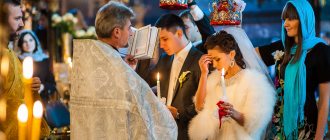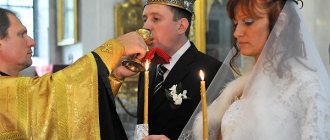A wedding is a church wedding ceremony that has a long history and plays an important role for believing couples. If the registry office solemnly unites your names on a piece of paper called “Marriage Certificate,” then the church unites your souls before the face of the Lord. If you are quite religious, or extremely sentimental, the wedding ceremony will strengthen and ennoble your union.
YesYes has prepared an article for you about the rules and laws of this wonderful church sacrament.
Why is official marriage registration required before a wedding?
- Legal certificate. A civil marriage is an officially concluded marriage. Anything else is called cohabitation, in the church lexicon - fornication.
- Marriage is not celebrated in the Sacrament; in the Wedding, a legal marriage is filled with the grace of God for the creation of a family as a domestic church. Until 1917, marriage was concluded (registered) in the church. Therefore, the sequence should be normal: first the ticket, and only then the ballet.

- If someone believes that the “stamp in the passport” does not matter, then nothing prevents him from entering into a legal marriage and taking legal responsibility for his wife and future children. If he refuses to do this, then this means that this is an important obstacle for him, and not a trifle.
- 92% of women in adulterous cohabitation consider themselves married, and 85% of men in it consider themselves single!
- A man traditionally proposed marriage to a woman. First the hand - full responsibility and only then the heart - feelings.
Among strangers: the cruelty of saints towards Gentiles
Another traditional type of “strike of a saint” is associated with the defense of the interests of Christianity from those of other faiths. Such episodes are present, for example, in the lives of saints who converted other nations to their faith.
Thus, Leonty of Rostov managed to bring the settlement of pagan Merians to Christianity. Arriving in foreign lands, he decided that it was useless to exhort adults whose views had already been formed, and turned exclusively to young pagans. The indignant Merians came to Leonty and his companions, “the Ovi with weapons, and the Druzians with drekoli,” planning, if not to kill the missionary, then at least to drive him out of the city.
In response, the future saint organized a religious procession, and at the sight of him, some of the Gentiles fell dead, and the rest instantly became blind. However, Leonty immediately revived the dead and restored sight to the blind - amazed by his miracles, the Merians voluntarily were baptized.
Not all Christian missionaries were as lucky as Leontius (however, some rare versions of his life report that he was later killed by pagans). More often than not, clerics traveling to foreign lands became victims of local residents who did not want to renounce their faith. The images of saints who were able to lay a crowd of foreigners dead and then revive them showed both the strength of the Christian faith and the almost unbearable difficulties that awaited those who went to distant lands on a spiritual mission.
For the wedding it is necessary
- the bride and groom be church-going Christians (faithful);
- register the marriage in the registry office (first the marriage is concluded, and only then it is consecrated; it is impossible to consecrate something that does not yet exist);
- preliminary interview with a priest;
- a wedding pair of icons - the Savior and the Mother of God.
- wedding candles - sold in the Church Shop;
- towel (wedding towel) - plain: white (for laying under your feet). Long enough for two people to stand on;
- wedding rings. According to the Church Charter, rings must be made of different metals: the groom’s ring is gold, the bride’s ring is silver (it is advisable to observe this).
On the eve of the wedding, everyone should partake of the Holy Mysteries of Christ
Each of the newlyweds must confess and receive communion on the eve of the wedding. And also fast and read prayers.
A woman should look appropriate, preferably as modest as possible. She should be wearing a dress or skirt, preferably below the knee, with a scarf on top.
Men entering the temple must take off their hats. You should wear trousers and preferably a shirt.
Also an important point for women. You cannot enter the temple during critical days. Therefore, the wedding day must be calculated in advance so that it does not fall on these days.
Schedule your wedding for safer days. This also applies to the witness; she should also discuss this with the bride in advance.
In the temple you must behave quietly, not talk, listen to prayers and chants.
When the day and time of the wedding have been discussed, the newlyweds need to purchase wedding icons - the Most Holy Theotokos and Jesus Christ.
Wedding Icons of the Blessed Virgin Mary and Jesus Christ
Witnesses can also purchase them as a gift to the newlyweds.
Requirements for witnesses
- in pre-revolutionary Russia, a church marriage had legal force, so the wedding was necessarily performed with guarantors - popularly they were called groomsmen or best men, and in liturgical books - heirs; the guarantors confirmed with their signatures the wedding act in the registry; they, as a rule, knew the bride and groom well and vouched for them;
- currently, the presence of witnesses is not a mandatory, but desirable condition for the celebration of the Sacrament of Marriage; this is a tradition, not a canon: their presence is determined by the desire of the bride and groom;
- the modern role of witnesses is to spiritually support those entering into marriage with prayer and advice based on the experience of their godly Christian marriage;
- it is advisable to find witnesses who are Orthodox and God-loving, and therefore churchgoers;
- Divorced spouses or people living in a “civil” (not registered in the registry office) marriage cannot become guarantors for a wedding. The first, not retaining the grace they received in the Sacrament of Wedding and setting a bad example for the newlyweds, cannot be faithful mentors for the family being created. The latter, living in fornication, cannot begin the Church Sacraments at all until they stop their ungodly relationships.
What you need to prepare for a wedding
If an elderly husband and wife decide to get married, then they should take into account the peculiarities of selecting various things and clothing that are necessary for organizing the ceremony.
Wedding rings
According to Orthodox tradition, for a wedding in a church you need to prepare separate rings. Those used in the registry office will not work. But some modern churches often allow you to take the same pair of rings that were worn when officially registering your marriage. Please check this point with your chosen priest.
The groom is in charge of buying the rings. Many couples order products from the same metal. If we turn to Orthodox traditions, then the groom should have a gold ring, and the bride a silver one. But in any case, it is up to the spouses to decide: the priest will not express dissatisfaction with such inaccuracy.
The presence of precious stones and complex patterns in rings is undesirable. This rule can be broken, but it is better to follow the Orthodox order of preparation for the wedding
If for some reason you cannot buy two new rings, you can use an alternative option:
- grandparents' rings;
- distant relatives;
- parents.
There are several signs regarding wedding rings. It is better to buy jewelry on the same day and in the same store. Neither before nor after the ceremony, no one other than the bride and groom should try on rings.
Icons
Preparing for a wedding for married people inevitably includes the purchase of ritual attributes. According to tradition, the priest must bless the couple with icons of the Savior and the Mother of God. The image of the Virgin Mary is given to the bride, and the image of Christ is given to the groom.
It is good if the parents bring the icons to the church, but on the condition that they will be present at the ceremony.
It is not customary to go through the wedding procedure without icons.
It is recommended to purchase the following options:
- Savior. Icon of Christ Pantocrator or Savior Not Made by Hands.
- Mother of God. The Kazan or Vladimir Icon of the Mother of God, as well as the image of the Iveron Mother of God.
If you want more Orthodox paraphernalia, you can buy icons of Peter and Fevronia. They are considered the personification of a family pleasing to God.
Wedding candles
Organizing a wedding includes the mandatory purchase of candles. Without them, the ceremony will not take place.
During the sacrament, the priest blesses those entering into a church marriage three times. After they make the sign of the cross in front of the altar, the priest gives the bride and groom each a lighted candle.
The sermon plus the rituals takes about an hour. For this reason, you need to buy long candles. You should not take ones that are too wide: they are uncomfortable to hold.
It is recommended to prepare saucers or handles in advance that will protect the skin from hot wax. Lace napkins, potholders and handkerchiefs are suitable for this purpose.
You can buy candles in white, yellow and pink shades.
White towel
Preparation for the wedding of married people includes the purchase of a special towel (foot). It is recommended to take linen products. The names of the bride and groom can be embroidered along the edges of the towel, but the center should remain pure white.
You'll need another towel. When the wedding ceremony begins, the newlyweds should bandage their hands as a sign of the unity of two people. For this part of the ceremony, it is better to buy white cotton or linen towels. Such a thing can be decorated with lace or an Orthodox pattern.
Some features of the bride's clothing
- the bride must have a headdress covering her head (veil or scarf);
- shoulders must be covered (cape, scarf, veil);
- the dress is white. If people who have already been married for some time are getting married, or are getting remarried, then the bride is no longer required to wear a white dress;
- cosmetics - in minimal quantities.
- because If you also have to attend the Liturgy on the wedding day, then in total, in terms of time, it will take several hours. To keep you comfortable, consider wearing comfortable shoes.
What to do before the wedding
Before the ceremony, you will need to go through an interview with the priest, where all issues related to the wedding process will be discussed.
In some churches, three public talks are held to divide the communication by topic.
In such a conversation, the priest explains what responsibility a person in love takes upon himself when entering into a church marriage. The clergyman gives parting words and reveals key biblical truths regarding the family.
During the conversations, discuss all organizational issues, including the cost of the wedding. You need to ask boldly, using a pre-compiled list of discussion topics.
Such conversations can last from 30 minutes. up to 2 o'clock. The date of communication is set 1 or 2 weeks before the sacrament takes place.
Before the ceremony you will need to undergo certain rituals.
Confess
Before the wedding you need to cleanse yourself of your sins. It is better to do this on the last day before entering into a church marriage. The man and woman must confess separately because it is an intimate spiritual process.
The confession procedure itself boils down to a sincere conversation with a priest, during which they talk about their sinful actions.
The minister has heard many confessions, so there is no need to be shy about him. The ritual is performed in front of the lectern (stand for icons and holy books). First, the priest reads a special prayer, after which the penitent speaks about his sins.
Next, the head of the person who has undergone confession is covered with an epitrachelion. You need to confess with the understanding that all words are directed to God, and the priest is only a mediator.
Take communion
To get married in a church, you must receive the grace of God. Communion is celebrated for this purpose. The essence comes down to using consecrated bread and wine in a special way.
You can receive communion immediately after confession is completed. It is advisable to fast before this ritual - another form of cleansing.
In some churches, the sacrament of communion includes saying one's full Christian name.
Stand the fast
Orthodoxy allows different formats for refusing food before the wedding takes place. You can fast from 1 to 3 days. During this time, you should not consume animal products. Alcoholic drinks and smoking are prohibited.
You can prepare any dishes from plant products. It is also important to refrain from overeating.
When choosing a one-day fast, it is recommended to maintain restrictions during the last day and night before the couple is married.
Orthodox fasting includes one more condition: before the wedding one should abstain from sexual activity. This restriction applies to the last 3 days before the ceremony.
At this time, you need to read at least 3 prayers included in the canon.
When people get married in a church, the rules and preparations may be slightly different. If you have any personal desires, discuss them with the priest.
Age of those getting married
- the lower age limit for performing the Sacrament of Wedding should be considered the onset of civil majority, when it is possible to conclude a marriage in the registry office;
- Church marriage law also sets the highest limit for marriage: for women - 60 years, for men - 70 years. This rule does not apply to those already married.
The Church does not sanctify a union between or with...
- Gentiles - representatives of non-Christian religions (for example, Muslims). A non-Christian cannot participate in an Orthodox sacrament, which is a wedding.
- unbaptized;
- atheists, even baptized ones;
- people who are related by blood and spirit;
- people whose officially confirmed mental illness deprives them of the opportunity to freely and consciously express their will.
- Orthodox Christians, with permission, can marry non-Orthodox Christians (Catholics, Protestants, Lutherans, Armenian Gregorians) provided that their children are baptized and raised in Orthodoxy. In special cases, an exception may be made for religiously mixed marriages. Only the ruling bishop can give a blessing for this;
- Consisting of: consanguinity (up to the fourth degree of relationship, for example, with a second cousin); in a spiritual relationship (if those wishing to marry are godparents of the same person or wish to marry a godson).
What to get married in
Preparation also includes choosing a wedding dress. Clothing for an event that will take place in an Orthodox church requires special attention. It is better if the girl wears a light-colored dress or a white outfit. You should absolutely avoid dark (brown, purple) and especially black outfits. The meaning here seems to be clear. White and light symbolize purity and chastity. Black and dark - mourning.
As for the length that the bride's clothes should have, it is desirable that the length be floor-length. Maximum - up to the knees. And, by the way, as you may have guessed, trouser robes are in no way suitable for the sacrament.
It is preferable that for the ceremony in the Orthodox Church the girl chooses a closed dress.
The back, neckline and shoulders must remain covered.
Behavior in the Temple during the Sacrament of Marriage
- The Sacrament of Wedding is not just a ritual, it is a prayer; treat with attention and reverence the prayers that are pronounced by the priest: during the entire Sacrament, the Church prays for almost no one else, just for the bride and groom (and one prayer “for the parents who raised them);
- everyone present at the wedding, to the best of their ability (with prayers, their words and thoughts), should pray for those two who are getting married;
- If possible, refrain from unnecessary conversations.
The meaning of the Sacrament of Wedding
Man and woman were created by the Almighty for connection, harmonious complementarity and joint improvement:
“A man will leave his father and mother and cleave to his wife; and the two will become one flesh” (Gen. 2:24).
During the wedding, the marriage union of a man and a woman is sanctified by God and the Holy Church. The relationship between spouses takes on a higher spiritual dimension and becomes a step on the path of approaching the Lord. Thus, the Sacrament does not replace marriage, but complements it.
The Church does not consider an unmarried, registered marriage to be fornication. However, Orthodoxy calls all Orthodox Christians to sanctify their marital relationships. Archpriest Pavel Velikanov notes:
“Without a church blessing, it will not be easy for Christians to build their marital relationships so that they become a ladder to the Kingdom of Heaven.”
The grace received at the wedding spiritually transforms sincerely believing newlyweds and helps them build a family. However, the Sacrament itself does not guarantee “automatic” family well-being. Husband and wife must make their own efforts to build family relationships. That is, they need to strive in practice to live like a Christian. Venerable Paisius the Svyatogorets teaches:
“Spouses should, as far as possible, cultivate the virtue of love, so that the two are always united as one and so that the Third, our Sweetest Christ, dwells with them” (Words, volume 4).
Tradition of parental blessing
- the groom and his parents come to the house of the bride’s parents and ask them for their daughter’s hand in marriage;
- upon consent to marriage, parents on both sides bless the newlyweds for a family union: the groom with the icon of Christ the Savior, the girl with the icon of the Most Holy Theotokos;
- the young make the sign of the cross and kiss the holy images;
- handing over icons, parents say that the time of raising children is over for them and with faith and hope they entrust their children to the all-powerful intercession of the Lord and Mother of God;
- icons, after the Wedding, are placed in the red corner, in the house where the bride and groom will live - these are the first icons of their family iconostasis.
- If one of the parents is not alive, then the survivor blesses;
- If parents are against marriage and do not want to give blessings, then you should contact your confessor and ask his advice on how valid the parents’ opinion is, is it based on selfishness or life experience and prudence.
Protection and support: punishment for encroachment on the weak
Perhaps most consistent with modern ideas are episodes from medieval sources where saints punish people for atrocities against those who are much weaker than the criminal. Descriptions of these cases were frightening even centuries later. For example, in the 19th century, the publisher of the life of Herald of Aurillac (Aurillac) in the Patrologia Latina series did not dare to include the following episode in the printed text - the fragment was published much later.
So, a woman from Limoges visited the tomb of St. Gerald. On the way back, she was raped by a certain horseman. Although any attack on pilgrims was condemned, it was not stopped either by the fact that she was returning from a holy place, or by the very name of Herald. Soon - apparently by the will of the saint - the criminal’s genitals decomposed and fell off. Even after this, he did not repent of what he had done, although the compiler of his life clearly expected this: for a medieval person, such a sudden illness was an understandable sign requiring repentance. However, the sinner did not admit his guilt, so a few days later he drowned in the river, which means he could not repent of his sins even before death - such a fate was feared by any Christian of that era.
This type of punishment from above is quite understandable today. But in this life there are many other examples of frighteningly, from our point of view, cruel punishments, and for much lesser crimes. By the will of the saint, norm-breakers are struck by sudden illnesses, their hands dry up, and the skin peels off their bodies in an instant. Paradoxically, all these facts do not make Herald cruel, from the point of view of the compilers of his life.
On the contrary, they constantly emphasize how gentle a person he was. The saint came from a noble family and could become a warrior, like the generations of his ancestors. Instead, he abandoned secular life and marriage and founded a monastery on his lands, where he later rested. The life mentions that Herald's associates called him timid, shy, almost effeminate. Hagiographers also report that during his entire life in the world he did not inflict a single wound - just as he himself was not wounded, although he participated in battles.
To some extent, these descriptions can be considered a commonplace, characteristic of lives - the saint must be portrayed as kind and meek, not accepting violence. However, these characteristics also partially revealed a specific medieval view of harsh punishments. Herald scholar Matthew Kuefler writes:
“...their cruelty was so built into the structure of the world and was such a common feature of human life that even saints could go on a rampage.”
Brief description of Engagement
- The Betrothal Rite (precedes the Sacrament of Wedding) - seals the mutual promises of those entering into Marriage and marks the fact that Marriage takes place before the face of God, in His presence, according to His all-good Providence and discretion.
- The ritual begins with censing. The priest blesses the groom three times, who makes the sign of the cross each time, then the bride, saying: “In the name of the Father, and the Son, and the Holy Spirit” and gives them lighted candles. Candles symbolize pure and fiery love, the chastity of the bride and groom and the grace of God.
- Prayers are said praising the Lord; prayers for those getting married on behalf of all those present in the Temple. Then, at the command of the priest, all those present bow their heads before the Lord, expecting spiritual blessing from him. The priest secretly reads a prayer, after which he puts a ring on the groom, making the sign of the cross three times, and on the bride. After the blessing, the couple exchange rings three times in honor and glory of the Most Holy Trinity, which accomplishes and confirms everything.
- A prayer is said to the Lord that He Himself will bless and approve the Betrothal and send a Guardian Angel to the bride and groom in their new life.
Where does the preparation for the wedding ceremony begin?
People who have been baptized can participate in the ceremony. In order for the wedding to go well, it is important to properly prepare for it.
Choosing a church and priest
For a church marriage, you can choose any parish that will be convenient for the bride and groom. The best option is when the church fits into the logistics of the wedding. It should be convenient for guests to get to the designated location for the sacrament.
The number of guests must also be taken into account. Not all temples can accommodate many people. Those who adhere to quarantine and are planning a wedding next year should take into account that restrictive measures may be extended into 2022. For this reason, it makes sense to look for small churches with a cozy atmosphere.
If there is no celebration other than the wedding, then you can choose one of two options:
- The church where the bride or groom was baptized.
- The parish that the future husband or wife visits.
It is important that the spouses come to an agreement on which church they will get married in - Orthodox or Catholic. The same rule applies to the patriarchy. If you want to enhance the significance of the moment, you can perform an engagement ceremony.
Not all priests will make a couple feel comfortable. Therefore, talk to the clergyman before approving his candidacy.
Select the date for the sacrament. Discuss all organizational issues, finding out the current rules, the cost of the ceremony and possible prohibitions in the church.
Selection of witnesses and photographer
Guarantors (witnesses) must be close people - relatives or good friends. It is important that they are baptized.
There are categories of people who cannot be taken as witnesses:
- divorced;
- married people who want to get married to someone other than their spouse;
- living in a civil marriage;
- those who are not yet married (sometimes allowed).
After the wedding, the witnesses will be considered spiritual relatives of the newlyweds, so you need to make an informed choice.
You need to look for a photographer for a wedding in a church among those specialists who have already had experience photographing the sacrament in a church. A person without such skills may miss the basic requirements. For example:
- do not come close to the priest and the altar during the ceremony;
- do not take photographs of those getting married when they stand with their backs to the icons;
- do not pass between the newlyweds and the royal doors.
It is important that the photographer knows how to work in dim church lighting. To shoot well in such conditions, you need skill and a fast lens.
When communicating with a photographer, you need to discuss what exactly is included in the price of his services, in addition to the high quality of the images. It could be:
- number of selected and processed frames;
- the presence of group photos after the wedding ritual;
- processing of all photographs (sharpness correction, cropping, color correction);
- additional printing of selected images in large format, etc.
Pay attention to the timing of the work. Some parishes may not allow filming in the church. Therefore, it is better to find out all the nuances from the beginning.
It is not necessary to negotiate a full price with the photographer: you can select only suitable types of services.
Brief description of the wedding
- Following the priest with the censer, the bride and groom with lighted candles enter the middle of the temple. The choir greets them with singing, glorifying their God-blessed marriage.
- In front of the lectern (on which lie the cross, the Gospel and the crowns) a white cloth is spread on the floor. Those getting married stand on it. The priest asks questions to the groom (then the bride) - whether they confirm a free and relaxed desire to get married and the absence in the past of each of them of a promise to a third party to marry him.
- The priest proclaims the blessing, then the litany is pronounced.
- This is followed by three prayers in which the priest asks the Lord to bless this marriage and give children.
- At the end of the prayers, the priest marks the groom with a crown, gives him to kiss the image of the Savior attached to the front of the crown and says: “The servant of God is getting married...”. The image of the Blessed Virgin Mary is attached to the bride's crown.
- The newlyweds, adorned with crowns, stand before the face of God, awaiting God's blessing. Exclamation: “Lord our God, crown them with glory and honor!” pronounced by the priest three times with a triple blessing of the bride and groom.
- If possible, guests silently help the priest, repeating: “Lord, our God! Crown them with glory and honor!”
- Then the Epistle to the Ephesians is read (Eph. 5:20-33), in which the marriage union is likened to the union of Christ and the Church.
- The Gospel of John (John 2:1-11) is read about God's blessing of the marital union and its sanctification.
- The litany is pronounced.
- After the proclamation: “And grant us, O Master, to dare to call upon You with boldness and without condemnation...” all those present at the Sacrament sing “Our Father.” As a sign of submission and devotion to the Lord, the bride and groom bow their heads under the crowns.
- The cup of communion (with red wine) is brought and the priest blesses it for mutual communion between husband and wife. They take a sip of the common wine three times, after which the priest connects the husband’s right hand with the wife’s right hand, covers their hands with stole and places his hand on top of it, signifying that the husband receives a wife from the Church itself, uniting them in Christ forever.
- Signaling the marriage as an eternal procession hand in hand, the priest leads the newlyweds around the lectern three times with the singing of troparions: “Isaiah, rejoice...”, “Holy martyr” and “Glory to you, Christ God, praise of the apostles...”. At the end of the solemn procession, the priest removes the crowns from the spouses and addresses them with welcoming words.
- What follows is a prayer to the Lord for the reception of the newlyweds’ crowns undefiled and undefiled in the Kingdom of God. The second prayer (with the newlyweds bowing their heads) - these same petitions are sealed with the name of the Holy Trinity and the priestly blessing.
- The chaste kiss of the newlyweds is evidence of holy and pure love for each other.
- Now the newlyweds are led to the royal doors, where the groom kisses the icon of the Savior, and the bride kisses the image of the Mother of God; then they change places and are applied to the icons again. Here the priest gives them a cross to kiss and hands them two icons: the groom - the image of the Savior, the bride - the image of the Most Holy Theotokos.
For sleeping and drunkenness: punishment for disrespect
Another type of situation where saints could show a harsh disposition was when a person treated them with disrespect. Then the saints took rather harsh measures to point out the mistake to the insolent people, and at the same time to those around them. The Lives do not skimp on terrible details in order to impress the reader and instill in him awe of the image of the saint.
Studying the sources, one can notice how broadly their compilers understood disrespect for saints. For example, we find a characteristic episode in the same life of Leonty of Rostov: these events occurred many years after his death, when Leonty had already been canonized. Once on the day of his memory, a miracle happened - at night the saint rose from the tomb, the church where he rested was filled with fragrance, and angelic singing sounded in it. By morning, the candle at the tomb, lit by the angels, continued to burn. After the service, one of the church ministers wanted to extinguish it and was immediately punished: he became deaf and numb, his arms and legs stopped moving. The cleric recovered only after he repented of all his sins.
However, the saints did not always send illness for disrespect; sometimes it was enough to ignore the person’s requests. This was the fate that awaited the lame boy who visited the tomb of St. Thomas Becket in the hope of being healed. To turn to the saint, the young man had to lie down on the slab covering the tomb - this was the traditional method of healing at the saint’s grave. Alas, lying on the stove, the tired boy soon fell asleep. Thomas Becket appeared to him in a dream, cursed the sick man for his insolence, and then declared that he refused to grant him health.
The saints punished Christians not only for disrespect for them personally, but also for violating the rules established by the church. For example, the life of Martin of Tours tells about a woman who, contrary to the ban, worked on Sunday. Her hand became numb, and her fingers did not leave her palm until the offender came to church and vowed never to work on the holy day again.
Believers could also suffer for their careless attitude towards church holidays. Such a case is described in the Volokolamsk Patericon, a collection of stories about the servants of the Joseph-Volokolamsk Assumption Monastery. One day a company of lay neighbors gathered to properly celebrate the day of the apostles Peter and Paul. The friends brewed mead, and one of them came up with the idea to start celebrating even before the church service. Having drunk quite a bit, he saw a man with a black beard and a noticeable bald spot, “with a terrible look.” The stranger hit the mead maker on the cheek so hard that five of his teeth fell out and the drunkard “lay like dead” for a long time, almost completely paralyzed.
Having barely come to his senses, he told his loved ones about what had happened, and they, based on the description of the terrible man, guessed that it was the Apostle Paul himself - he is usually depicted as bearded and almost bald. The unfortunate drunkard never recovered, and his relatives took him to a monastery, where he died a year later.
Pseudo-church superstitions associated with weddings
- younger brothers/sisters cannot marry earlier than older ones;
- you cannot get married while pregnant;
- You cannot get married or get married on a leap year;
- a fallen ring or an extinguished wedding candle - portends all sorts of troubles, a difficult life in marriage or the early death of one of the spouses;
- the one of the couple who first steps onto the spread towel will dominate the family all his life;
- the one whose candle turns out to be shorter after the sacrament will die earlier;
- You can’t get married in May, “you’ll suffer for the rest of your life.”
How can you get debunked?
- The dissolution of a God-blessed Marriage is a great sin, therefore there is no such thing as “debunking”. It is impossible to bless sin; the Savior Himself commanded: what God has joined together, let not man separate (Matt. 19:6). In Orthodoxy there are no destructive rites at all: baptism, debunking, defrocking. What is given liturgically is terminated by the decision of the bishop.
- If the first marriage actually broke up, then the innocent party may be given a blessing for the second marriage, and, as a last resort, for the third, but no more. A blessing can only be given by the diocesan bishop, but not by the priest.
About gifts from witnesses
After the sacrament of wedding is completed, it is customary to present the couple with gifts. The custom also applies to witnesses. Gifts are chosen that are symbolic, reminiscent of the date of the ceremony, the bright feelings and thoughts that fill the newlyweds on a memorable day.
Among the options for gifts from witnesses are:
- handmade icons or purchased in the temple;
- figurines of guardian angels;
- wedding photo album;
- pendants with the faces of saints;
- wedding silver cups engraved with the date of the event;
- personalized tableware;
- buildable photo frame for family photos.
It is not customary to give money for a wedding. Witnesses, at their discretion, buy individual gifts or one for two.











